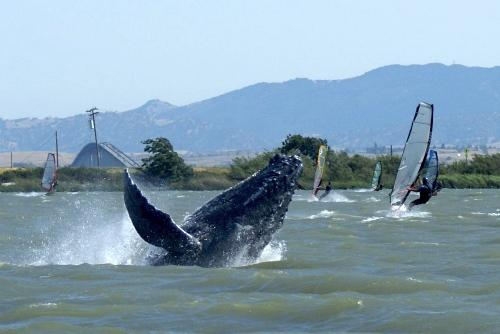

Humpback Whale (Delta/Dawn) breaching in Sacramento River S. Wilkin/NOAA OPR
Each winter and spring, gray whales migrate near shore between Arctic feeding and Mexican breeding grounds. In spring, especially, gray whales can wander into San Francisco Bay, San Diego’s Mission Bay, and into Tomales Bay – a shallow arm of Greater Farallones National Marine Sanctuary. In addition, the prime season for humpback whales foraging off California is April through November, although humpbacks can be present here at any time year-round.
While here they face dangers from disturbance, stress, and harassment caused by human activities, shipstrike, and entanglement in fishing gear. Sometimes, whales that are present are already suffering from disorientation and other natural conditions affecting their health.
To prevent disturbance, NOAA’s National Marine Sanctuaries advises watching for a whale’s blow, or exhalation, which looks like a puff of smoke. Humpback and gray whale blows are bushy, and rise to about 10 feet. Be aware there may be whales nearby that you do not see!
Boaters, including paddle boarders and kayakers, should not:
- Approach a whale within 300 feet (the length of a football field);
- Cut across its path,
- Make sudden speed or directional changes, or
- Get between a cow and her calf: if separated, the calf could starve.
Marine Mammal Protection Act / Endangered Species Act
Remember: All marine mammals - whales, dolphins, porpoise, seals, sea lions and otters - are protected under the Marine Mammal Protection Act. Additionally, many are also protected under the Endangered Species Act. Power boaters and paddlers must resist temptation to float alongside or otherwise interfere with whale and other marine mammal movements and behavior. The Marine Mammal and Protection act defines minimum distances and harassment and the corresponding fines of up to $10,000. To read about what constitutes harassment, click here.
Never attempt to free a whale yourself. Entangled whales should be reported immediately to the National Oceanic and Atmospheric Administration (NOAA’s) Whale Entanglement Hotline: 1-877-SOS-WHALE.
Members of the public are encouraged to submit whale sightings information to NOAA through the free Whale Alert app to help track the distribution of whales. Sharing sightings on Whale Alert helps rescuers, researchers, and mariners reduce deadly vessel strikes.
If you encounter any dead or injured marine mammals, please report that to the NOAA West Coast Region Marine Mammal Stranding Hotline: 1-866-767-6114, the USCG, or other local Marine Wildlife Rescue organizations immediately. Check this information here (under EMERGENCY CONTACTS - MARINE WILDLIFE RESCUE).
Heading to the beach this summer? Remember to respect the wildlife you may encounter as you recreate in the beach and ocean. As a reminder to beach goers and boaters, please stay at least 50 feet away from elephant seals, sea lions, seals and other species protected by the Marine Mammal Protection Act. With the breeding season for sea lions occurring from late June until early August they can exhibit aggressive behavior defending their territory or protecting their pups. For your safety and theirs, do not take a selfie with them. They prefer you take photos from a distance.
Should you have an encounter with marine mammals, make sure you “share the road” and or the shore and maintain a respectful distance from our amazing marine wildlife.
